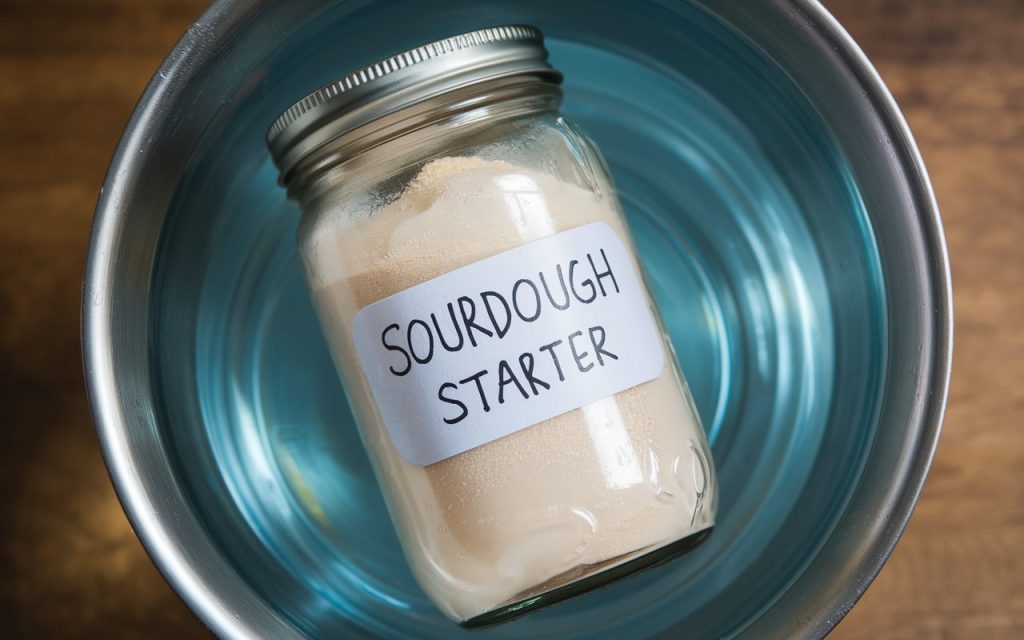Table of Contents
If you’ve ever wondered, Can you freeze sourdough starter? The answer is a resounding yes! Freezing sourdough starter is a simple and effective way to preserve its active cultures, especially when you don’t have time to maintain it regularly. In this article, we’ll explore how to freeze sourdough starter, why it works, and the perfect trick to ensure your starter remains healthy and strong even after it’s been frozen.
What Is Sourdough Starter?

Before diving into the freezing process, let’s briefly explain a sourdough starter. Sourdough starter is a fermented mixture of flour and water that captures wild yeast from the environment. This natural yeast allows bread to rise without the use of commercial yeast.
Can You Freeze Sourdough Starter? Yes, And Here’s Why It Works!
Can you freeze sourdough starter? is often asked by those who don’t bake frequently or need a break from maintaining it. Freezing works because the cold temperature slows down the fermentation process, keeping the wild yeast and bacteria dormant but alive.
Why Freezing Sourdough Starter is Effective:
- Preserves the yeast and bacteria: The low temperature puts them in a dormant state, but they remain alive.
- Convenience: Freezing allows storing the starter for weeks or months without regular feeding.
- Long-term storage: If you don’t bake regularly, freezing the starter can help maintain it over long periods without spoilage.
How to Freeze Sourdough Starter: Step-by-Step Guide
Freezing your sourdough starter is easy, but there’s a right way. Follow this step-by-step guide to ensure your starter stays strong and healthy.
Step 1: Feed Your Starter
Before freezing, make sure your sourdough starter is well-fed. Feed it 4-6 hours before freezing to ensure it’s active and bubbly. An active starter will freeze better and wake up faster when thawed.
Step 2: Let It Rest
Once fed, allow your starter to sit at room temperature for a few hours to become fully active. You’ll notice bubbles forming, a good sign of a healthy, active starter.
Step 3: Portion It Out
Divide your starter into smaller portions to make it easy to thaw. You can freeze portions in separate containers or freezer bags. Each portion should be about ½ cup to revive your starter for future baking.
Step 4: Store in a Freezer-Safe Container
Place each starter portion into a freezer-safe container or resealable plastic bag. Leave some space in the container, as the starter may expand slightly when frozen.
Step 5: Label and Freeze
Label your containers with the date to track how long they have been frozen. Once labeled, could you place them in the freezer?
How Long Can You Freeze Sourdough Starter?
You might wonder, Can you freeze sourdough starter for months? The answer is yes! Sourdough starter can be frozen for up to 6 months without losing effectiveness. However, aim to use it within three months to ensure it remains vibrant and easy to revive for the best results.
Best Practices for Storing Sourdough Starter in the Freezer:
- Use airtight containers to prevent freezer burn.
- Label your starter with the freezing date for easy tracking.
- Try to freeze in smaller portions for faster thawing and easier use.
How to Thaw and Reactivate Your Frozen Sourdough Starter

Once you’re ready to bake again, thawing and reactivating your frozen sourdough starter is a breeze.
Step 1: Thaw the Starter
Remove your frozen sourdough starter from the freezer and let it thaw in the fridge overnight or at room temperature for a few hours. Make sure it’s fully thawed before moving to the next step.
Step 2: Discard Some Starter
After thawing, discard about half of the starter to ensure the yeast and bacteria have room to grow and feed properly.
Step 3: Feed the Starter
Feed the thawed starter with equal parts of flour and water. Let it sit at room temperature for 4–8 hours, depending on how active it becomes. You’ll know it’s ready when bubbles form, and it starts to rise again.
Step 4: Repeat Feeding
If your starter isn’t fully active after the first feeding, don’t worry! Feed it again in 12 hours. Repeat the process until it’s back to its usual bubbly self. This may take a day or two, but your starter will return strong.
The Perfect Trick: Freeze Starter in Smaller Portions
The perfect trick to freezing sourdough starter is to divide it into smaller portions before freezing. This makes it much easier to thaw just the right amount when you need it without defrosting the entire batch. Smaller portions also freeze faster and reactivate more quickly, saving time and ensuring consistent results.
Benefits of Freezing in Portions:
- Faster thawing: Smaller portions thaw more quickly, so you don’t have to wait long to use your starter.
- Less waste: Thaw only what you need and keep the rest frozen for future use.
- Easier feeding: It’s easier to revive smaller amounts, ensuring your starter is active and healthy sooner.
Avoid these common mistakes when freezing sourdough starter.
While freezing sourdough starter is simple, there are a few mistakes to avoid:
- Freezing an inactive starter: Ensure your starter is active and well-fed before freezing.
- Using too much starter at once: Always discard half before reactivating it to give it enough space to grow.
- Not feeding it enough after thawing: Your starter may need a few feeding rounds to become fully active.
Also read: Can You Froth Creamer? Unlock the Magic Within for Foam!
Can you freeze the sourdough starter? The answer is a definite yes, and it’s an incredibly convenient way to preserve your starter for future use. You can enjoy hassle-free sourdough baking whenever you’re ready by following the perfect trick of freezing it in small portions. Remember, with just a little care and patience, your sourdough starter will return to life, prepared to create delicious homemade bread again.




